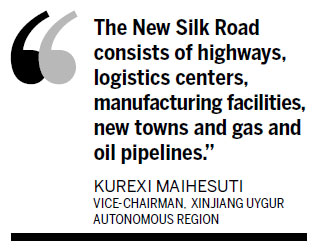Nations agreed to build New Silk Road

China will enhance partnerships with its neighbors to the west, aiming to build an integrated regional communications network, a top Chinese official said on Monday.
Vice-Minister of Industry and Information Technology Shang Bing said that this network will help China, the Central Asian nations, Russia and Mongolia to accelerate their economic recoveries and promote multilateral trade.
Communications services have become one of the most dynamic and fastest-growing industries for developed nations, creating jobs in sectors such as e-commerce and logistics. A number of developing countries have also realized that this industry can be an aid to their economies.
"Developing information services will not only help countries in the Eurasian corridor reduce their heavy dependence on trade in natural resources - they will also find new ways to diversify their development modes," Shang said.
At the Third China-Eurasia Expo held in Urumqi on Monday, China Telecom Corp Ltd, China Unicom Hong Kong Ltd and China Mobile Hong Kong Co Ltd signed seven cooperative agreements and business memoranda with the governments of Kazakhstan, Tajikistan, Russia and Mongolia, and companies in those countries, to build communication facilities
Along with infrastructure improvements, such as road and bridge construction along the Eurasian Land Bridge (also known as the New Silk Road), "China and partner countries will share common resources in promoting trade in both regional and European markets through an improved communication network, which adopts the same signal system and service standards," said Shang.
The Silk Road came into being some 2,000 years ago. Running for 7,000 kilometers, the ancient trade route was forged by camel-driving merchants who carried silk and porcelain to western Europe and spices to the Far East. The road lost its significance as the age of seaborne commerce dawned.
"The New Silk Road consists of highways, logistics centers, manufacturing facilities, new towns and gas and oil pipelines.
"It is time to boost this region as a backward communication system can create economic burdens such as unsold goods, lack of information and erroneous investment policies in the Eurasian heartland," said Kurexi Maihesuti, vice-chairman of the Xinjiang Uygur autonomous region.
China has built three major international communication hubs in Nanning, Kunming and Urumqi, along with five regional centers and 50 international channel gateways. Using 10 cross-border submarine cables, 35 cross-border land cables and international communication satellites, the nation's mobile roaming network covers 253 countries and regions.
Located in Northwest China, Urumqi, the capital of Xinjiang, became China's third international communications hub in 2011. It has more than 230 Internet technology and telecommunication enterprises, nearly half of which have business connections with the markets of neighboring countries.
The Chinese government has selected Xinjiang as the base to coordinate regional communications with countries in Eurasia passage.

























